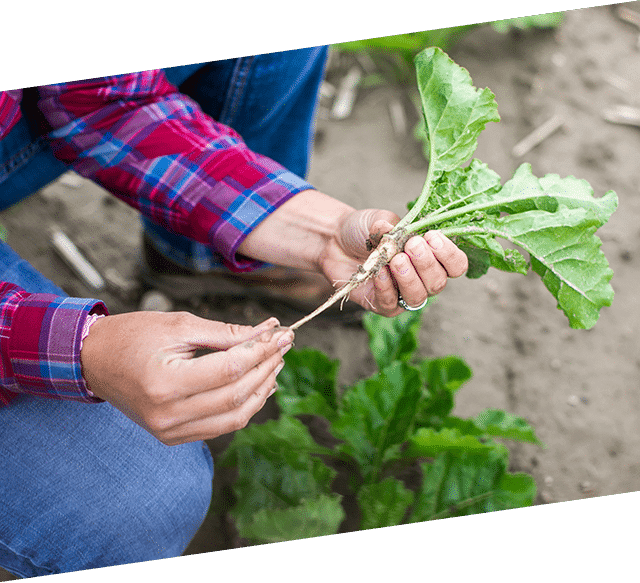Growing
and production
Approximately half of all sugar produced in the United States comes from sugarbeets. We are there every step of the way, from sugarbeet to sugar bowl.
How Our Sugar is Grown

1
Planting Seeds
Tiny sugarbeet seeds, about half the size of a pea, are planted in the spring in rows of loamy soil.
2
Seedling Growth
Seedlings emerge about one to three weeks after a seed has been planted. Photosynthesis starts as soon as seedlings have emerged and are exposed to sunlight.


3
Canopy Growth
The leafy canopy of the sugarbeet is essential to perform photosynthesis. Leaves consistently grow out in pairs, and their full size or “row closure” usually occurs in mid-summer. Once they are fully developed, the plant shifts from top growth (leaves) to root growth.
4
Root Development
Through the process of photosynthesis, the sun’s energy is absorbed by the canopy and converted into sugar that is deposited in the root of the plant which acts as a storage system.


5
Sugar Accumulation
At the end of the growing season, once sugar has accumulated in the root, sugarbeets are harvested, stored and transported to the factory for processing.
How Our Sugar is Made
1. Sugarbeet Harvest
Special harvesting equipment is used to remove the leaves from the sugarbeet. Another piece of equipment is then used to lift the sugarbeet roots from the soil and transport them to receiving stations or directly to a factory. Each truck load is sampled to evaluate its sugar content and quality as beets are delivered and stored. The sugarbeets are then transported to a factory.
2. Washing & Handling
Once at the factory, all sugarbeets are thoroughly washed to remove excess soil and debris before being sliced into thin strips called cossettes, which are about the size of french fries.
3. Diffusion
The cossettes are sent to a diffusion tank where they are placed in hot water. Sugar is diffused from the cossettes into what is now called raw juice.
4. Separation
Raw juice is sent to juice purification, while the solid beet pulp is sent to mechanical presses where residual water is pressed out. The pressed pulp is then sold directly to dairy or beef cattle operations or dried and sold as a nutritionally-rich livestock feed.
5. Purification
Lime and carbon dioxide (CO2) are used to purify the raw juice, removing impurities using a clarifier and filters. In this process, the raw juice becomes a highly pure sucrose solution called thin juice.
6. Evaporation & Concentration
Thin juice is concentrated and turned into a syrup called thick juice. Thick juice is enriched with raw sugars in a melter, producing standard liquor. Standard liquor is further concentrated in vacuum pans causing sugar to crystallize.
7. Crystallization
In order for crystals to grow uniformly, tiny sugar crystals are added to the standard liquor. After reaching the right size, the crystals are separated from the remaining syrup with high speed centrifuges. The sugar is then washed with clean water, revealing its naturally white appearance.
8. Drying & Packaging
The crystalized sugar is dried and cooled. The sugar is then screened and classified by granulation size. It is packaged accordingly and shipped either by truck or rail.



